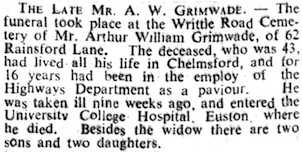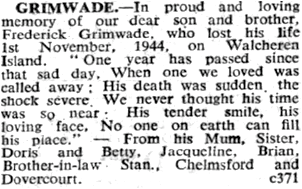Frederick William Grimwade was born and raised in Chelmsford, living in Rainsford Lane. During the war he served in the Royal Navy. He was killed in action in November 1944 during an amphibious attack on Walcheren Island in The Netherlands.
Frederick was born in Chelmsford in 1924, the son of Arthur William Grimwade (1897-1940) and Emily Grimwade (nee Waskett) (1895-1978). The couple married in 1923, Frederick had a sister, born in 1926 and a brother born in 1933.
In 1927 the family were living at 62 Rainsford Lane, Chelmsford.
Frederick William GRIMWADE, Able Seaman, H.M.L.C.F. 37, Royal Navy
Killed at Sea near Walcheren, The Netherlands. Aged 21
Being roughly 1,500 yards off the shore, I altered course to port, from the last zig-zag, informing the Officer Commanding Royal Marines (O.C.R.M.) to stand by for our assigned target when in range, and rang the emergency full ahead.
The craft was receiving so much punishment I could foresee that if we sustained any more, there was a danager of sinking before we were in range of our target, so I informed the Officers tat I was not turning back to carry out more repairs, and intended, if necessary to beach the craft, and fight it as a beach fort.
On this, Lieutenant Cowper, Royal Marines (O.C.R.M.) who had previously ordered all the gun crews to keep their heads down, warned the men again, and from my observation I must comment on the discipline and courageous way that the Royal Marine detachment under his orders were keeping to their action stations without flinching or having any personal feelings to their danger a credit to the Corps.
Still under heavy fire, we received a final hit direct to the main magazine, at approximately 0948, which blew up causing heavy casualties to officers and men stationed amidships and forward.
From there, myself, I draw a blank for a short period. Lieutenant Cowper Royal Marines was blown from the bridge on to the cat walk, where he helped a wounded rating into a Carley Float. Lieutenant Kenchington Royal Navy Volunteer Reserve went amidships and helped two ratings who were swimming in the shell of the ship amidships.
On coming to, I extracted myself from the wreckage on the bridge, and examined the wheel house which was abandoned and on fire. Amidships was a complete mess of twisted metal, all the upper decks, guns, zaberes, etc. blown completely away. Generators were on fire in the engine room, and I failed to find anybody.
Observing survivors in the water some way off, and the ship still under shell fire, I took to the water as I considered the craft would sink in a few minutes.
Information I received afterwards that Lieutenant Kenchington and two injured ratings did not leave the ship, as the raft they were on was swept back into the hold and L.C.I. 527 took them off later and then proceeded to pick up the remaining survivors in the water.
It is submitted that this L.C.I.(S) did most valuable work in rescuing the wounded survivors so near the beach, under shell fire and machine-gun fire,which we came under from the shore batteries whilst we were waiting to be picked up."
At the time of his death Frederick's mother was still living at 62 Rainsford Lane in Chelmsford.
Frederick has no known grave and is commemorated by the Plymouth Naval Memorial.
Frederick was a cousin of Herbert George Grimwade. His uncle, Herbert William Grimwade, won the Military Medal during the First World War.
140701

His father died, comparatively young, in a London hospital in 1940.
Frederick’s uncle, James Ellis Grimwade, was awarded the British Empire Medal, for bravely and skill helping to rescue four victims when properties in Marconi Road, Chelmsford were bombed on 9th May 1941, despite the grave dangers posed by the partially demolished buildings around him.
During the Second World War Frederick
served as Able Seaman D/JX 422876 with His Majesty's Landing Craft Flak 37, a converted landing craft used as an anti aircraft gun platform.
On 1st November 1944 the vessel participated in amphibious invasion by Royal Marine and army personnel on the Dutch island of Walcheren, then held by the Germans (Operation Infatuate). During the attack the vessel was lost and many men killed, including Frederick, then aged 21. The total casualties were 2 officers and 39 other ranks missing believed killed, 4 other ranks seriously injured, 2 officers and 3 other ranks slightly wounded. There were 29 survivors unwounded.
Two days later the craft's commanding officer, Lieutenant G.L/ Carlton, who survived the incident, submitted the following report:
"I have the honour to submit the following report, namely the loss of H.M.L.C.F. 37 under my command at 0948, 1st November, 1944, during the Walcheren operations at WESTKAPELLE.
At 0901 (approximately) I received a signal from Support Squadron Eastern Flank (S.S.E.F.) 'deploy and carry out orders in accordance with your previous instructions'; being the Senior Officer of the Southern Flank of L.C.R.s I immediately altered course slightly to the S.E. from BB. position to make for a position to run in between the sand banks for a close support attack in conjunction with L.C.F. 32 who was on my starboard beam.
For the first two miles we were subjected to very heavy shelling and it is estimated that 30 to 40 various calibre shells were fired at my ship, the majority falling exceptionally close, which necessitated a zig-zag course to be taken. It seemed to me that we were the main target and at 0920 we received our first direct hit on the waterline, port side aft which slightly damaged the steering, and wrecked the aft mess deck without loss of life (estimated by a 6" shell).
The damage control party under First Lieutenant (Sub. Lieutenant Harman) were quick on the scene, and with the aid of the hammocks and timber, prevented a considerable amount of water from entering the aft part. Whilst this was being carried out another shell struck port side aft, oerlikon [type of gun] gunpit and wounded one of the gun's crew, the next entered the forward oerlikon magazine, causing a fire, but before the fire party could be mustered another 6" partially took away our bows, and another hit P1, killing one of the gun's crew, and putting the complete gun out of action.
This caused the craft to become very sluggish, and I had great difficulty in conning the ship, when after a further salvoes of near misses and intense shell fore we received another hit on one of our wing tanks.
